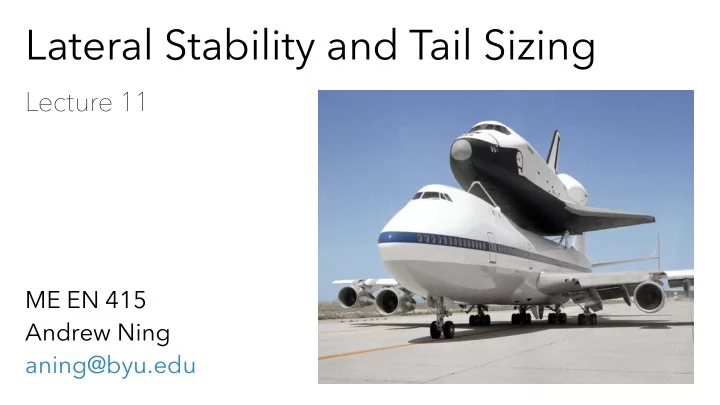

Lateral Stability and Tail Sizing Lecture 11 ME EN 415 Andrew Ning aning@byu.edu
Lateral Stability
Coefficients roll roll c roll = q ∞ S w b w n n c n = q ∞ S w b w
Yaw Stability β n
Roll Stability L Φ W flying into page
Dihedral φ Φ
Statistical Tail Sizing
74 AIRCRAFT DESIGN AIRFOIL A Somemulti-engine aircrafthave counter-rotating propellersto minimizethe most aircraft designs, the con' engine-out yawing. and control at the lightest wei The tails are also a key element of stability, acting much like the fins on an have such a tail arrangement others. arrow to restore the aircraft from an upset in pitch or yaw. Although it is possible to design a stable aircraft without tails, such a design is usually penalized in some The "T-tail" is also widely tional tail because the vertica other area, as discussed in Chapter 20. The other major function of the tail is control. The tail must be sized to provide tail, but the T-tail provides co adequate control power at all critical conditions. These critical conditions for the Due to end-plate effect, thl the horizontal tail clear of horizontal tailor canard typically include nosewheelliftoff, low-speed flightwith more efficient and hence a:ll! flaps down, and transonic maneuvering. For the vertical tail, critical conditions the horizontal tail, which red typically include engine-out flight at low speeds, maximum roll rate, and spin recovery . Injet transport aircraft sud Note that control power depends upon the size and type of the movable surface engines mounted in pods on as well as the overall size of the tail itself. For example, several airliners use stylish, which is not a trivial The cruciform tail, a ce double-hinged rudders to provide more engine-out control power without increasing the size of the vertical tail beyond what is required for Dutch-roll arrangements, lifts the horize damping. Several fighters, including the YF-12 and the F-107, have used the B-1B), or to expose the all-moving vertical tails instead of separate rudders to increase control power. high angle-of-attack conditi< with a T-tail, but the cruci Preliminary methods for sizing tails are provided in Chapter 6, and stability and control analysis methods are provided in Chapter 16. However, the cruciform tail ~ effect as will aT-tail. The "H-tail" is used prim~ Tail Arrangement during high angle-of-attack c( in the propwash on a multie Figure 4.30 illustrates some of the possible aft-tail arrangements. The first Tail Types H-tail is heavier than the c. shown has become "conventional" for the simple reason that it works. For smaller horizontal tail. On the A-lO, the H-tai: heat-seeking missiles when' H-tails and the related triple. to allow an aircraft such a~ hangars. The "V-tail" (Fig. 4.31) is horizontal and vertical tail fOJ tions of the force exerted UP! and vertical tail area, the req from the Pythagorean theore the arctangent of the ratio of r wetted area of the V surfaces and vertical surfaces. However, extensive NAC satisfactory stability and con same total area as wouldbe re Even without the advantage e ference drag but at some pen and elevator control inputs m movement of the V-tail "rude When the right rudder pee Raymer, Aircraft Design Fig. 4.30 Aft tail variations. vator deflects downward, and
79 AIRFOIL AND GEOMETRY SELECTION Aft-strake or back porch 5 Flyingwing Raymer, Aircraft Design Fig. 4.34 Other tail configurations. ng ;ed canard capable of downward deflectionsof 45 deg or more can be used to put the Ity nose back down under almost any situation. This permits optimizing the wing's )le aspect ratio and sweep without compromising for pitch-up avoidance a&- (see Fig. 4.21), but requires a sophisticated flight control system. Such an :>st approach was used on the X-31, capable of flight at 90-deg angle of attack. A subtle aerodynamic benefit can be obtained with a canard configuration. ~e, If both wing and canard are highly swept, the canard vortex can be made to rol interact with the leading-edge vortex on the wing, increasing its strength and nd therefore augmenting its lift. This beneficialinterference is very geometry depen- its dent and is difficultto predict. The SAAB Viggen and Rockwell HiMatboth used this effect. er, Canard advocates sometimes claim a lift and trim drag advantage for the lal canard configuration when compared to an aft tail. It is quite true that the to canard's lift reduces the lift that must be produced by the wing. This permits a Ie. smaller wing and, all else being equal, would reduce the wing's drag due to te- lift. Traditional aft-tail designs frequently fly with a download on the tail to of produce natural stability, which increases the amount of lift that the wing must ed produce and therefore increases its drag due to lift and increases trim drag. ~r, However, a modem and sophisticated aft-tail aircraft is designed to a slight level of instability so that it normally flies with an upload, not a download ,se on its tail. This is the very reason that computerized flight control systems with artificial stability were developed and put into production, first on the ng
Statistical Tail Sizing V H = l H S H V V = l V S V c w S w b w S w
Control Surfaces
Flight Controls
Flight Controls
Recommend
More recommend